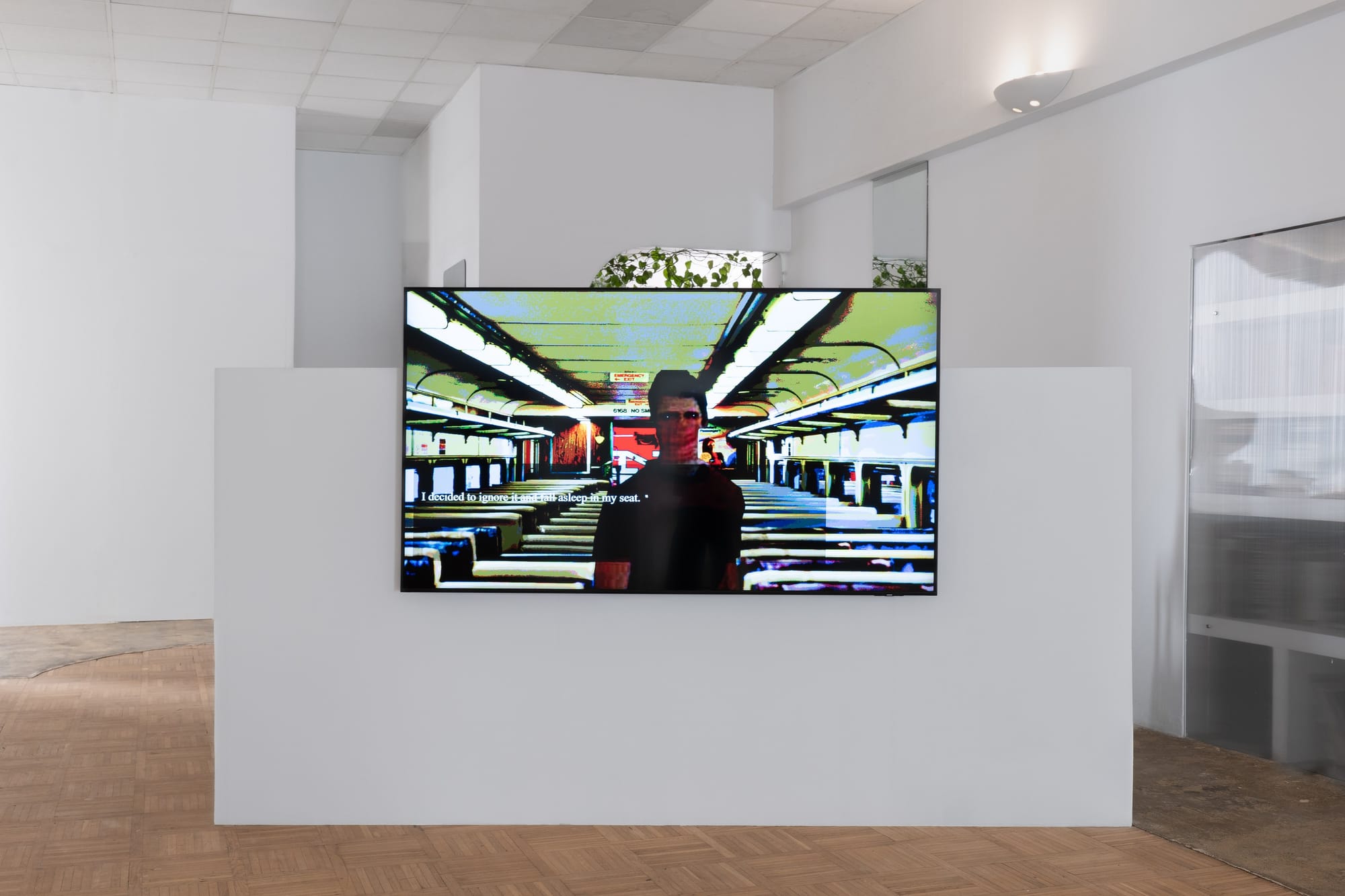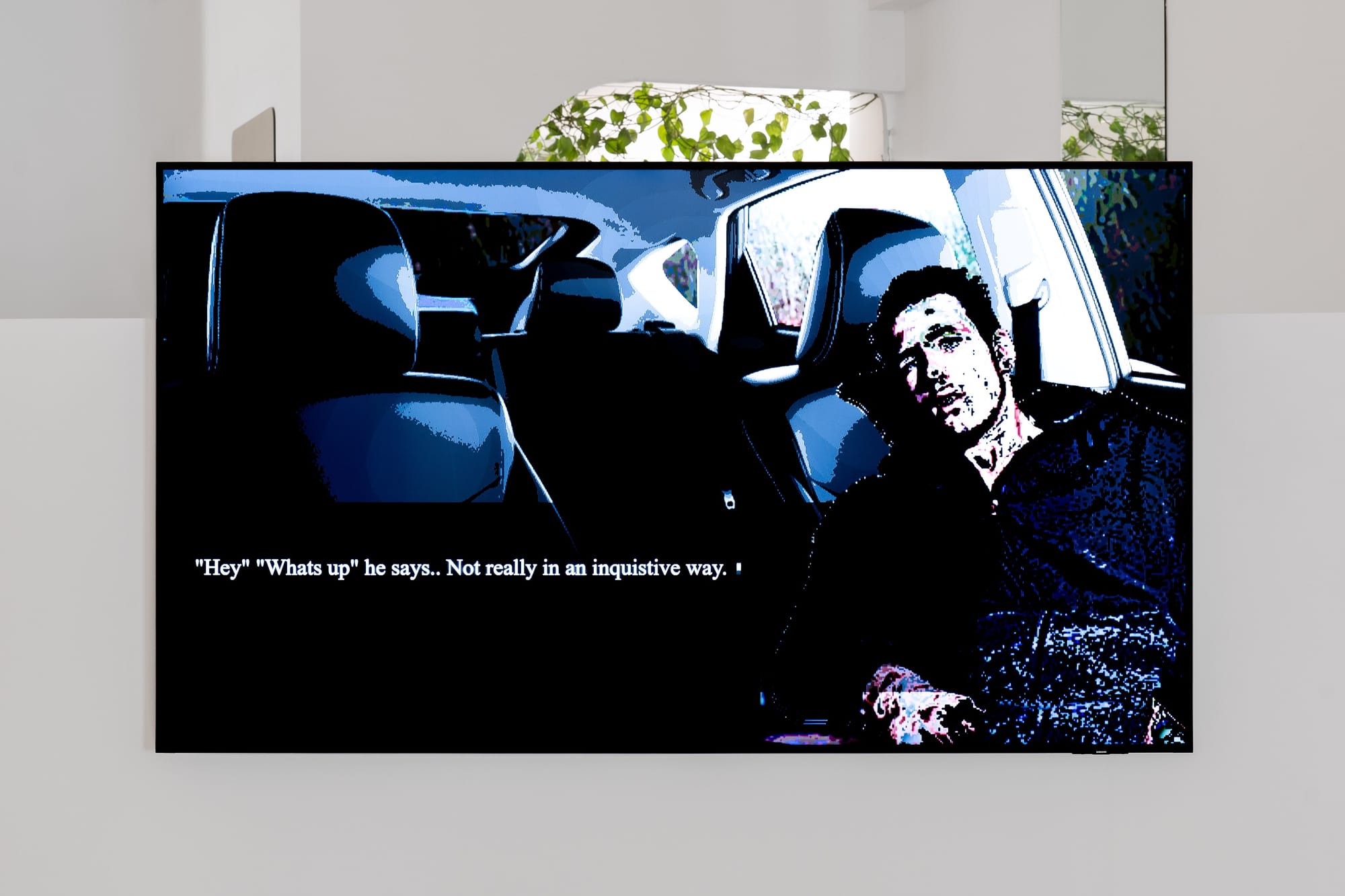ART GAME: TRADED INTIMACY: PLAYING ADAM MARTIN’S YOUR DEMISE
Adam Martin
Your Demise
July 10 – August 10, 2025
Giselle’s Books
Marseille, France
The title comes across like a threat addressed directly to the visitor: Your Demise. Adam Martin’s exhibition at Giselle’s Books in Marseille, France takes that second–person address seriously, treating everyone who enters as a “player” caught inside someone else’s script. The works here are visual novels – clickable games built from still images, text, sound and branching dialogue, for those unfamiliar with the genre – but Martin prefers to call them “suffering games”. They move slowly, sentence by sentence, click by click, using game mechanics to sustain unease rather than reward.

In the gallery, a single luminous screen interrupts an otherwise spare room. The monitor shows digital tableaux that oscillate between cartoon and noir: cropped avatars, shallow spaces, flattened textures, dialogue lines subtitling the image. Instead of the sensory overload associated with mainstream videogames, the pacing is stubbornly methodical. You sit, read, decide, click. The interface is simple, almost ascetic, which makes every small decision – accept, refuse, confess, look away – feel pointed.

Two visual novels anchor the show: Your Demise (2025), which gives the exhibition its title, and The Gotham Art Whores League (2024). Both are structured as chapter-based stories extracted from memories, composites and speculative scenarios. Martin has said that two of Your Demise’s chapters are grounded in his own recollections, while a third functions more as a writing experiment. Gotham Art Whores draws from his time in the fetish video industry and sex work, spliced with years of navigating the contemporary art world. The result is less confession than system portrait: scenes in which desire, money and performance circulate through bodies that never fully belong to themselves.

Martin grew up on comics, anime and early 2000s reality television, and you can feel those lineages throughout the installation. The compositions recall superhero splash pages more than cinema: central figures, high-contrast lighting, backgrounds treated as thin sets. Reality TV contributes another layer of influence: the direct address, the confessional tone, the sense that every encounter is both intimate and staged for an unseen audience. The work’s visual language feels closer to fanfiction cover art and early PC adventure games than to the lush hyperrealism of contemporary AAA titles.
Mechanically, though, Your Demise is very much a videogame. Martin builds on the conventions of the visual novel, but he uses those conventions to question what “choice” means in the first place. The games offer multiple paths and endings, yet the player never has enough information to make a fully informed decision. Scenes advance whether you hesitate or click quickly; routes close off without warning. The system reminds you that in games, as in life, agency is usually exercised within parameters designed by someone else.

Martin has spoken of “the illusion of choice” as central to these works, and of his belief that real agency lies in the ability to walk away. Within the story, however, that option is largely withheld. Once you start, you tend to keep going, absorbed in the loop of reading and responding, half-hoping for a better outcome. The act of clicking becomes a kind of low-level endurance test, an obligation rather than a gesture of mastery. These are games in which progression feels less like conquest and more like staying with a situation that hurts.

That hurt is inseparable from gender. Across Martin’s practice, the central figure is often a young man caught between bravado and vulnerability, rage and exhaustion. The protagonists of Your Demise and Gotham Art Whores move through late-night trains, back rooms, studios and anonymous apartments, carrying a mix of shame, desire and resentment that never quite resolves. Martin describes a “dance between masculinity, repression, violence, pressure, and my emo, overly sensitive side”, and the games keep that tension unresolved. Dialogue choices rarely allow for heroic self-knowledge; they tend instead to toggle between bad options and worse ones.
Martin’s works explores the “intersection of personal history and systems of power”, and the games treat institutional structures as engines. Employers, clients, galleries, shadow economies and informal networks of care all appear indirectly, through contracts, pay, gossip and expectations. What the player experiences is the affective residue of these arrangements: dread before a shift, numbness after a job, the nervous calculation of what each interaction might cost. Game mechanics translate these dynamics into repeating shifts, recurring conversations, choices that reset the same situations under slightly different conditions.
Just as important is the question of intimacy, especially the forms of “traded intimacy” that Martin explores. In Gotham Art Whores, sex work and the art world mirror one another: both revolve around managed exposure, negotiated boundaries and carefully priced access. The visual novel format sharpens this parallel. Every click is a micro-transaction of attention; every line of text is given or withheld by the system. The player is implicated as a consumer of stories that hinge on pain, desire and humiliation, and the games quietly ask what it means to treat such material as content.

Formally, the pieces lean into a productive awkwardness. Character models feel slightly generic, as if generated from a shared digital casting pool, yet their expressions, and the writing that accompanies them, render them strangely specific. Backgrounds sometimes look like stock environments, sometimes like photographs processed into game assets. Rather than masking those seams, Martin lets them show. The effect is to keep reminding you that these are worlds built from presets and templates, standing in for memories that are too messy to be neatly modelled. That tension between prefab systems and lived experience is where Your Demise is most compelling. On one level, the show offers a straightforward demonstration of how game engines and visual novel frameworks can be used within contemporary art. On another, it posits game mechanics as a way to think through the limits of self-authorship under conditions of economic and institutional pressure. You might control the cursor, but the story has already been mapped. The question is less how you win than how you keep going and whether, at some point, you decide to quit.
Martin’s exhibition arrives at a moment when visual novels and interactive fiction are gaining visibility beyond gaming culture, yet they remain relatively underexplored in art galleries. Your Demise suggests that this omission is a missed opportunity. By treating the click as both readerly gesture and game input, Martin connects literary form, fan cultures and the scripted freedom of games to broader questions about labour, sexuality and control.
The pieces are quiet, even modest, yet the situations they simulate linger long after you leave the screen behind.
Adam Martin (born in Iowa, USA) is a New York–based artist whose work spans visual novels, photography, sound and installation. Drawing on his own experiences in shadow economies, from the fetish video industry and sex work in Los Angeles to the professionalised circuits of the contemporary art world, he constructs interactive narratives that examine traded intimacy, institutional opacity and the pressured inner life of young men. His work has been shown at Galerie Buchholz in Cologne, Etablissement d’en face in Brussels, and the New York galleries Gandt and LOMEX, among others. Your Demise at Giselle’s Books is his first solo exhibition in France and marks a significant expansion of his ongoing investigation into games as engines for discomfort, memory and critique.
